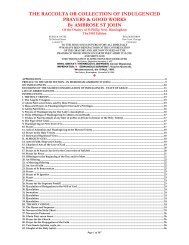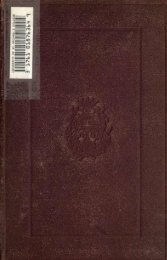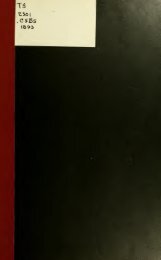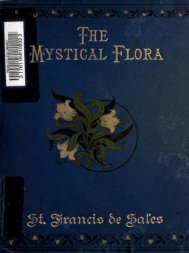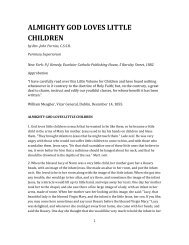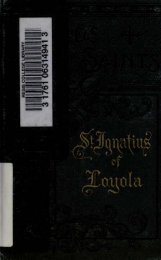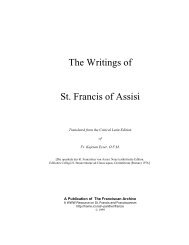Saint Anthony Mary Claret - Catholic Apologetics Information
Saint Anthony Mary Claret - Catholic Apologetics Information
Saint Anthony Mary Claret - Catholic Apologetics Information
You also want an ePaper? Increase the reach of your titles
YUMPU automatically turns print PDFs into web optimized ePapers that Google loves.
kitchen or refreshment counter to buy whatever food they needed.<br />
134. Other passengers did the same. They gave me money and I distributed it to the others, not<br />
keeping so much as a penny for myself although it had been intended for me. I didn't take a mouthful of<br />
the food they had bought; I was content with my water-soaked bread. The Englishman was very edified<br />
when he saw how poor and detached I was and how the others were eating food that they had bought<br />
with the money I'd given them, while I ate none of it. He told me that he was getting off at Leghorn and<br />
traveling overland to Rome. He gave me a card on which he had written his name and the address of the<br />
palazzo in which he would be staying and told me to come and see him and he would give me whatever I<br />
needed.<br />
135. This whole adventure confirmed what I had already believed: that the best and most effective<br />
means to edify and move people is good example, poverty, detachment, fasting, mortification, and selfdenial.<br />
Since this English gentleman was traveling in Oriental luxury, with his coach, servants, birds, and<br />
dogs aboard, one might imagine that my appearance would move him to contempt. But the sight of a<br />
priest who was poor, detached, and mortified moved him so deeply that he couldn't do enough for me.<br />
And not only he but all the passengers showed me great respect and veneration. Perhaps if they had seen<br />
me rubbing elbows with them at table, and ordering rich and elegant dishes, they would have criticized<br />
and looked down on me as I often saw them do with others. Virtue, it would seem, is so necessary for a<br />
priest that even the wicked want us to be good.<br />
136. After five days at sea we landed at Civitavecchia and headed for Rome, where we arrived<br />
without incident, through God's goodness and mercy. 86 How good you are, my Father. Let me serve you<br />
always with fidelity and love. Give me your constant grace to know what pleases you and the will power<br />
to put it into effect. My Lord and Father, I want nothing more than to know your holy will, so that I may<br />
do it; nothing more than to love you with all my heart and serve you with all fidelity. My Mother--<br />
Mother of Fair Love--help me!<br />
Chapter V<br />
ARRIVAL IN ROME AND ENTERING THE JESUIT NOVITIATE<br />
137. It must have been about ten in the morning when we arrived in Rome. The religious went to a<br />
house of their order and we parted company. I and the Catalan ordinand went to the nearest house to ask<br />
where any Catalan seminarians might be staying. We approached the entrance of the Carmelite priory,<br />
the Transpontina, 87 and asked the brother porter whether there was a Spanish religious in the house. He<br />
told us that indeed the head priest, Father Comas, was a Catalan. 88 We went to his cell and were<br />
welcomed. We asked him whether he knew of a place where there were any Catalan ordinands. He told<br />
us that there were some at San Basilio, and he was charitable and kind enough to accompany us there<br />
despite the fact that the Transpontina is about an hour's distance from San Basilio. 89<br />
138. The Catalan ordinands received us kindly although they had never seen or heard of us before. I<br />
began immediately to apply myself to the task for which I had made my journey. The only letter of<br />
recommendation I had was addressed to His Excellency, Bishop Vilardell, a Catalan, who had recently<br />
been consecrated bishop of Lebanon and had just left for his new post when I arrived in Rome. 90 I then<br />
86 The trip from Civitavecchia to Rome took seven hours. They made it on the same day they landed, as <strong>Claret</strong> says in a note: "In '39,<br />
Feast of Rosary, arrived Civitavecchia and Rome" (Writings, p. 464). They followed the Via Aurelia to the horsegate near Bernini's<br />
colonnade. This explains why the first religious house they came to was the Transpontina.<br />
87 The Transpontina was built in 1563 and is located halfway along the Via della Conciliazione, which was called the Via<br />
Alessandrina in those days. It is still a Carmelite priory.<br />
88 Fr. Edward Comas (1788-1865), Carmelite (1806), Apostolic Commissioner for the Spanish Carmelites (1839-64), pastor of the<br />
Transpontina (1841), Beneficiary of Bethlehem Church, Barcelona (1850), professor of philosophy (1854).<br />
89 San Basilio is located on the street of that name, between the Piazza Barberini and the Via V. L. Bissolati.<br />
90 Fr. Francis Vilardell, a Franciscan missionary for twenty years in Palestine, was Commissioner General of the curia for Franciscan<br />
missions. He was named titular Archbishop of Pilippi, Vicar Apostolic of Aleppo, and Apostolic Delegate to Lebanon on March 8 ,1<br />
839.<br />
30




